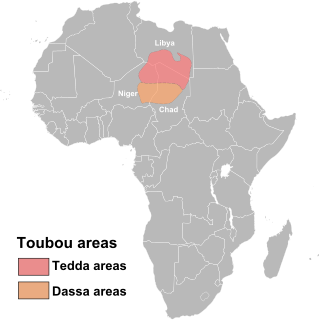
Daza is a Nilo-Saharan language spoken by the Daza people inhabiting northern Chad and eastern Niger. The Daza are also known as the Gouran (Gorane) in Chad. Dazaga is spoken by around 700,000 people, primarily in the Djurab Desert region and the Borkou region, locally called Haya or Faya-Largeau northern-central Chad, the capital of the Dazaga people. Dazaga is spoken in the Tibesti Mountains of Chad, in eastern Niger near N'guigmi and to the north. It is also spoken to a smaller extent in Libya and in Sudan, where there is a community of 3,000 speakers in the city of Omdurman. There's also a small diaspora community working in Jeddah, Saudi Arabia.
Central Ibibio is the major dialect cluster of the Cross River branch of Benue–Congo. Efik proper has national status in Nigeria and was erroneously made the literary standard of the Ibibio language, though Ibibio proper has more native speakers.
Igboid languages constitute a branch of the Volta–Niger language family. The subgroups are:
ISO 639-3:2007, Codes for the representation of names of languages – Part 3: Alpha-3 code for comprehensive coverage of languages, is an international standard for language codes in the ISO 639 series. It defines three-letter codes for identifying languages. The standard was published by International Organization for Standardization (ISO) on 1 February 2007.

There are over 525 native languages spoken in Nigeria. The official language and most widely spoken lingua franca is English, which was the language of Colonial Nigeria. Nigerian Pidgin – an English-based creole – is spoken by over 60 million people.
Bade is a West Chadic language spoken by the Bade people in Yobe State and Jigawa State, Nigeria. Their traditional ruler is the Emir of Bade. Similar to many other Western African languages, Bade is a vulnerable language at great risk of extinction. With 356,000 speakers, the language and the culture of the Bade people have suffered over the last several years. As the language continues to fade, the culture and historic value associated with the language perishes as well. The local dialect is shifting from Bade to Hausa. Across West Africa, the impact on local communities through the loss of the indigenous tongues will be significant. The endangerment of the Bade language represents the worldwide language diversity that is at risk. Many African languages have only received little linguistic attention, impacting these African languages.

The West Chadic languages of the Afro-Asiatic family are spoken principally in Niger and Nigeria. They include Hausa, the most populous Chadic language and a major language of West Africa.
Cakfem-Mushere is an Afro-Asiatic language cluster spoken in Bokkos LGA, Plateau State, Nigeria. Dialects are Kadim-Kaban and Jajura. Mutual intelligibility with Mwaghavul is high.
Chakato is a West Chadic language spoken in Plateau State, Nigeria. It was identified by Roger Blench in 2016. It is spoken by about 500 people in one village, Dokan Tofa, which is located on the Jos-Shendam road in Plateau State. Blench (2017) suggests that Chakato may be related to spurious records of the Jorto language. Chakato speakers claim that their language is closely related to Goemai.

Karai-karai is a language spoken in West Africa, most prominently North eastern Nigeria. The number of speakers of Karai-karai is estimated between 1,500,000 to 1,800,000 million, primarily spoken by the ethnic Karai-Karai people. It is an Afro-Asiatic language spoken principally in Nigeria with communities in Bauchi State, Yobe State, Gombe State and other parts of Nigeria. Many Karai-karai words share a common origin with the Northwest Semitic languages of Hebrew and Arabic. The Karai-karai language is most closely related to the Ngamo and Bole languages which are both considered derivatives of the Karai-karai language.
Zeem, or Chaari, is an endangered Chadic dialect cluster of Nigeria, whose speakers are shifting to Hausa. Dyarim is closely related.
Damakawa is a moribund Benue–Congo language of northwest Nigeria. The language has become extinct, there are no longer any speakers of the language, although the oldest people can remember a few words. Approximately 80 or so words and phrases were collected, with difficulty, in April 2008.
Ahwai, also called the Ndunic languages, is a Plateau language cluster spoken to the southwest of Fadan Karshi in Sanga LGA, Kaduna State, Nigeria. Most villages are located at the foot of the Ahwai Mountains in Kaduna State.
Kirya-Konzəl is a recently documented Chadic language of Nigeria, though it was first attested in 1931. The varieties, Fali of Kirya (Kirya) and Fali of Mijilu (Konzəl), are very close.
Ju is a language from the West Chadian branch of the Chadic language family. The language is spoken solely in Nigeria, and had approximately 900 native speakers in 1993. The language is unwritten.
Firan or Fəràn is a Plateau language closely related to Izere. Most Firan speakers are multilingual in Firan, Hausa, English, Iten and sometimes Berom.
Tunzu (Tunzuii), or Itunzu, also known as Duguza (Dugusa) in Hausa, is a Kainji language of Nigeria.
Zora (Izora), or Cokoba (Cokobanci) in Hausa, is a Kainji language of Nigeria.
Spurious languages are languages that have been reported as existing in reputable works, while other research has reported that the language in question did not exist. Some spurious languages have been proven to not exist. Others have very little evidence supporting their existence, and have been dismissed in later scholarship. Others still are of uncertain existence due to limited research.



